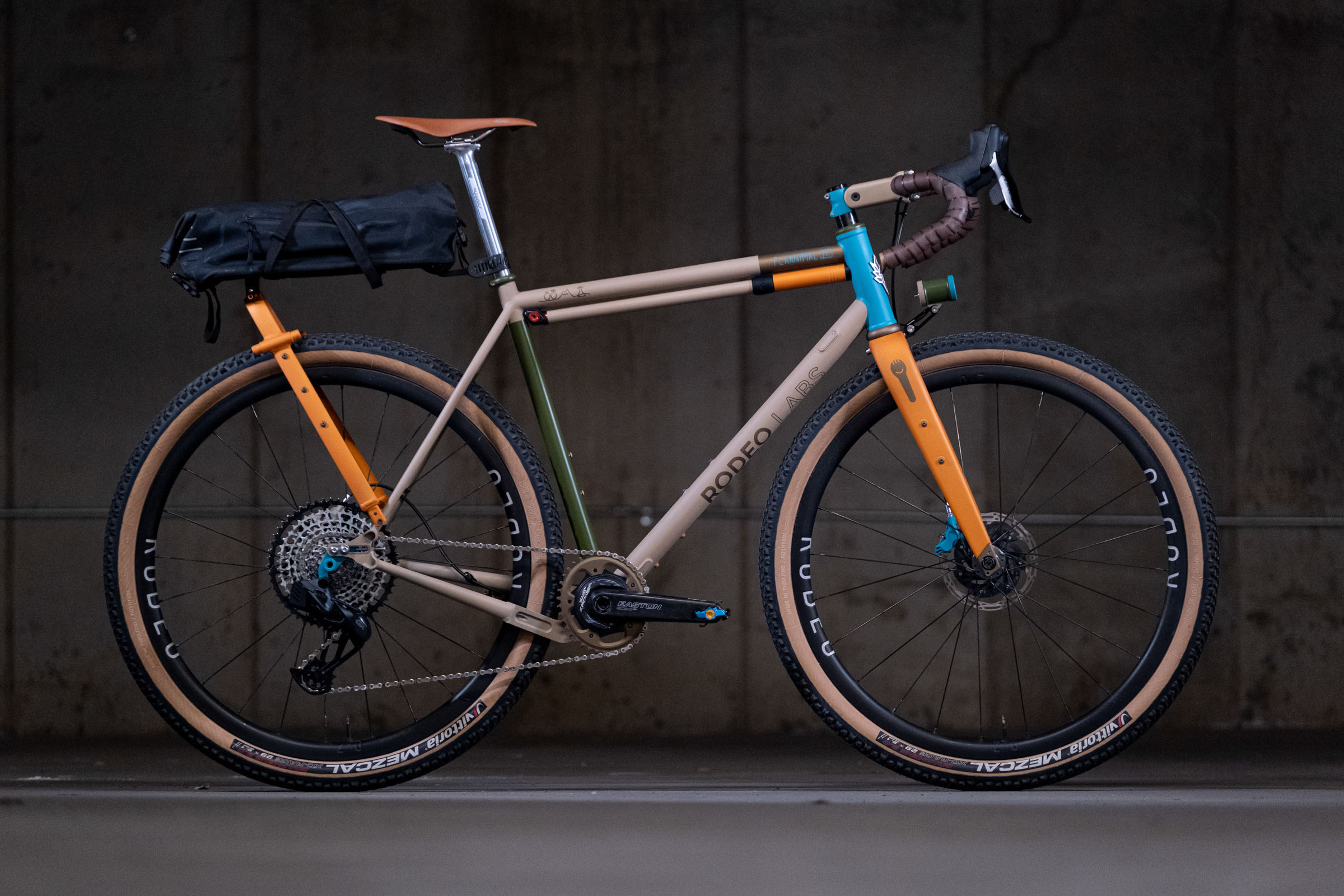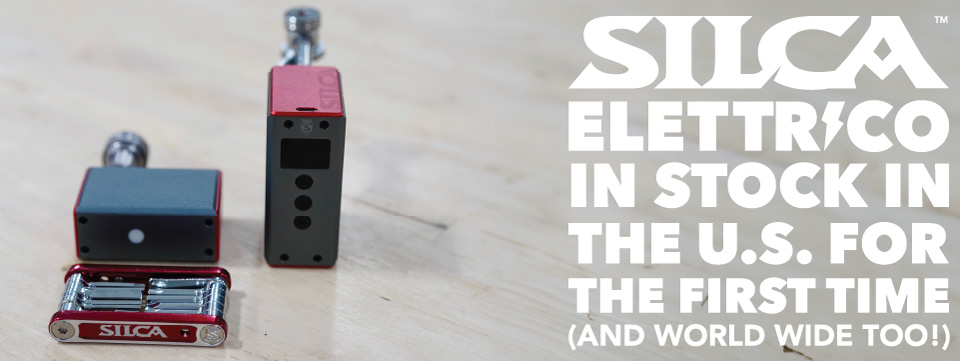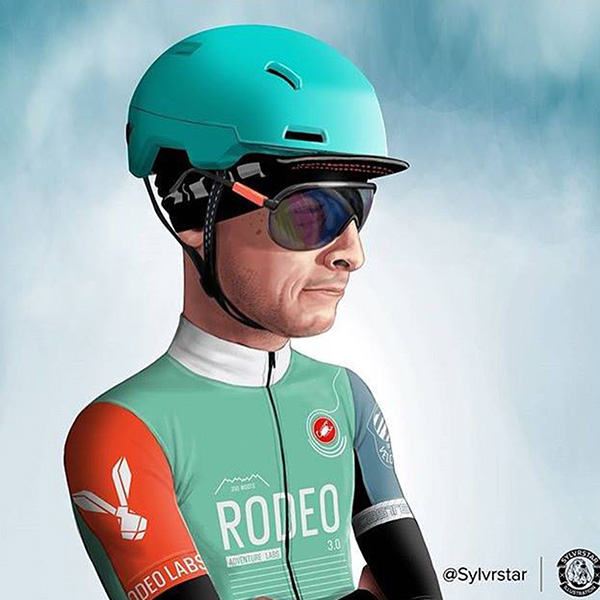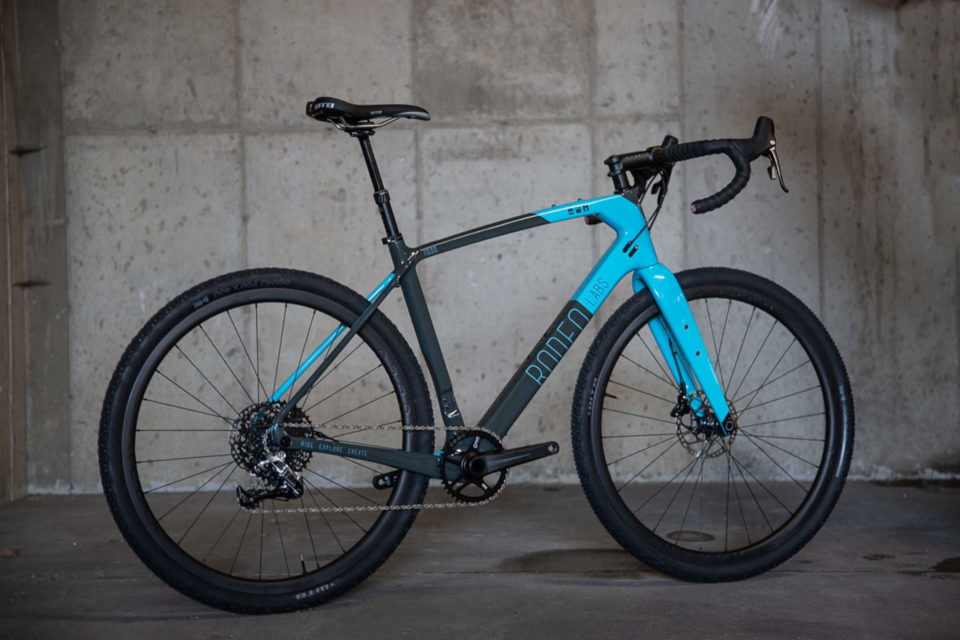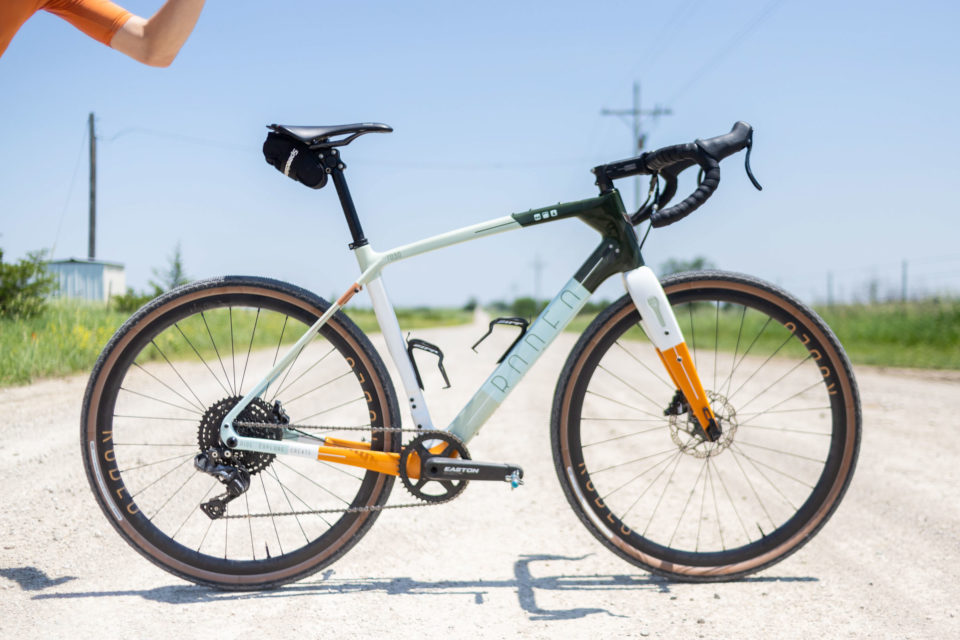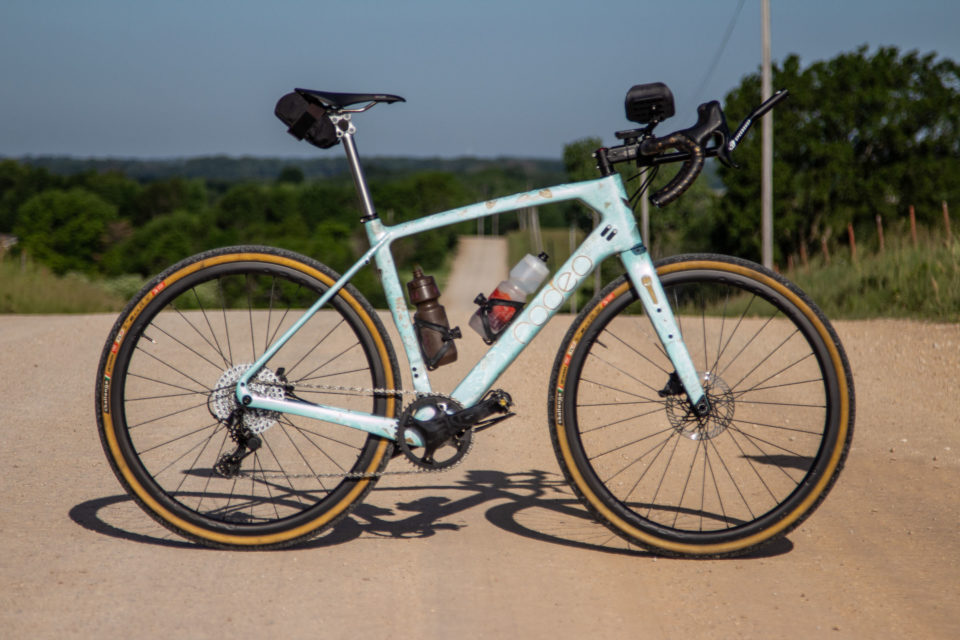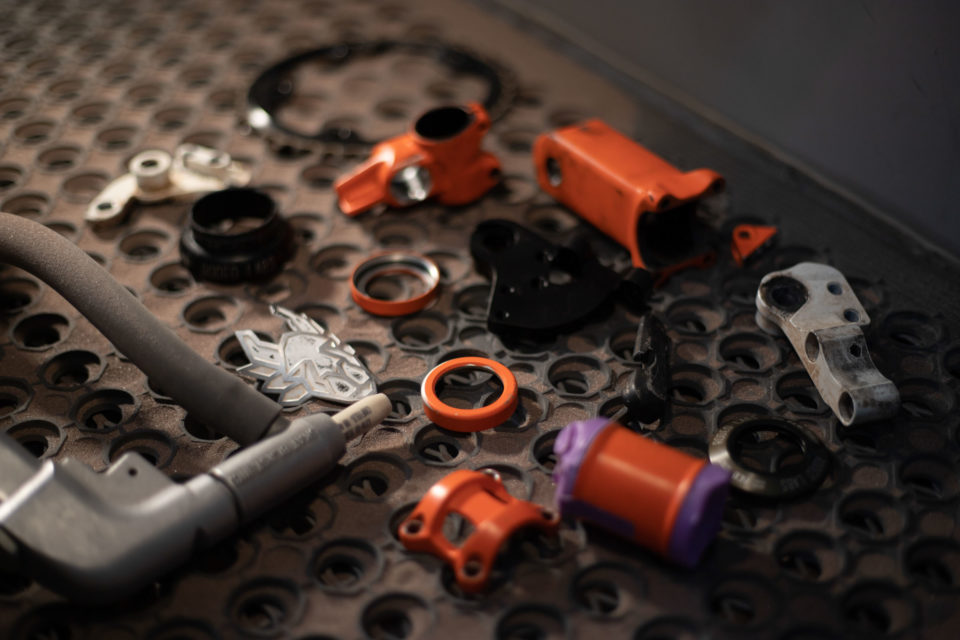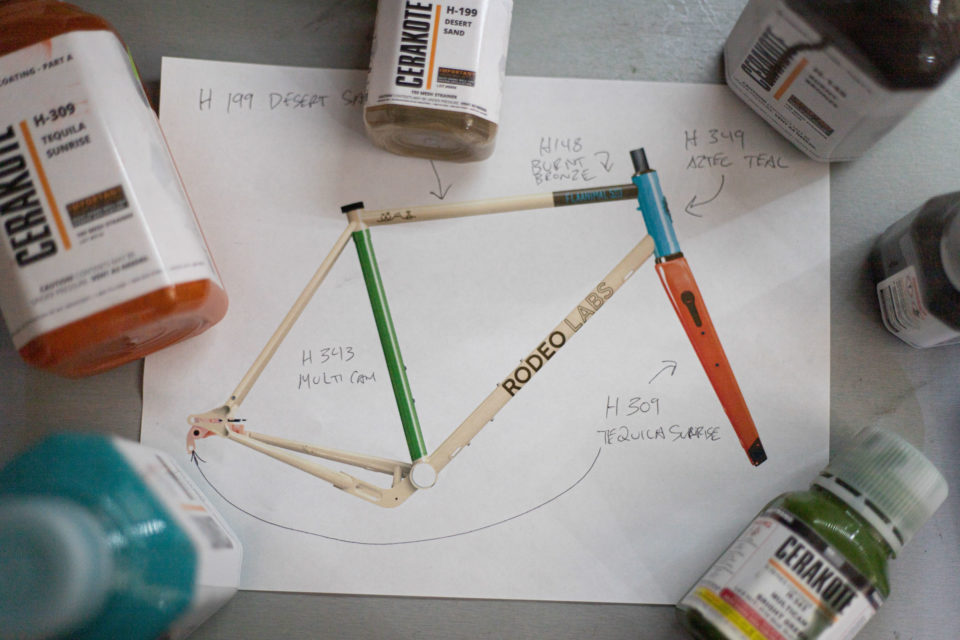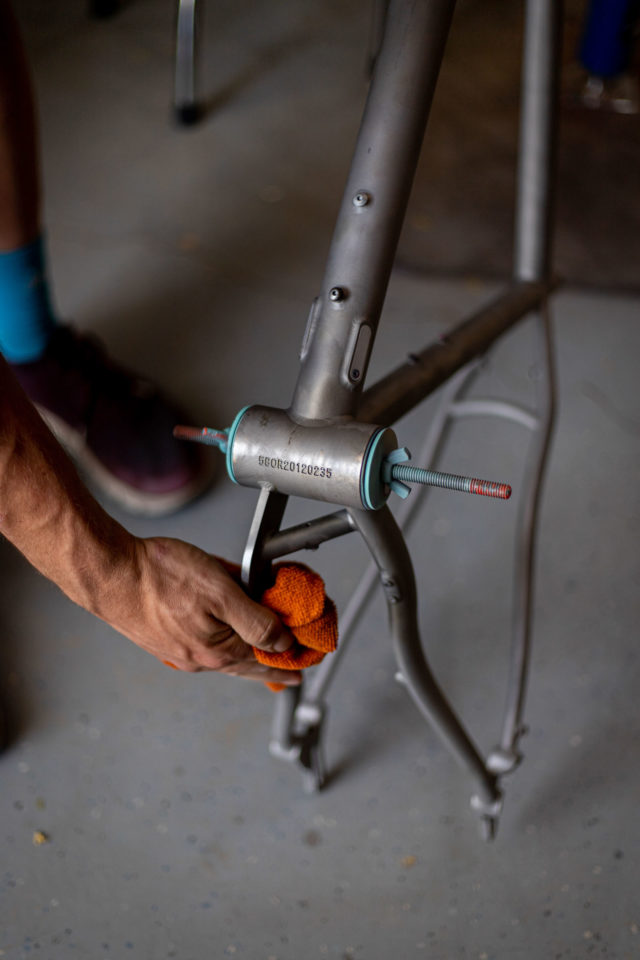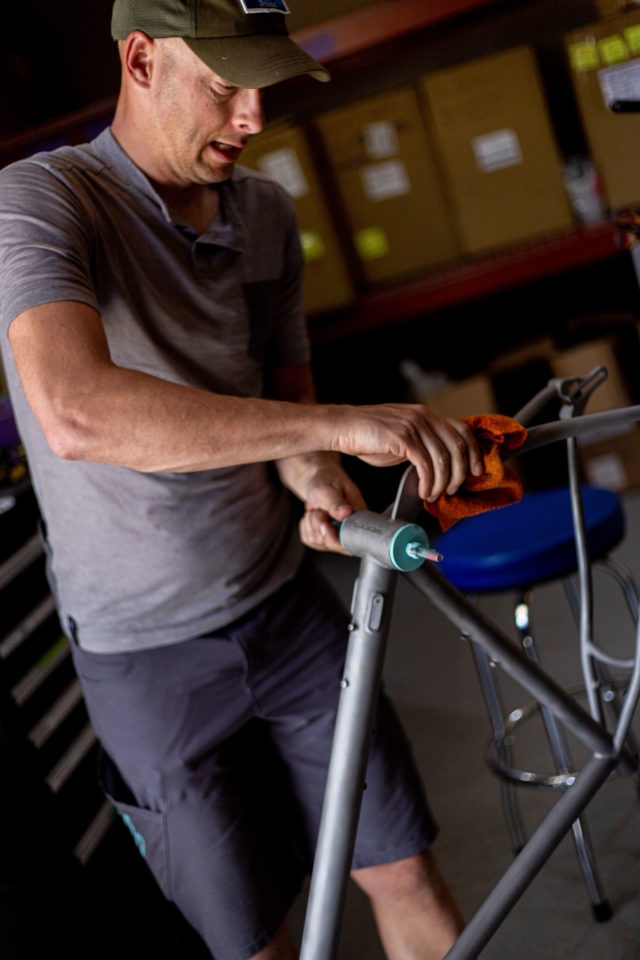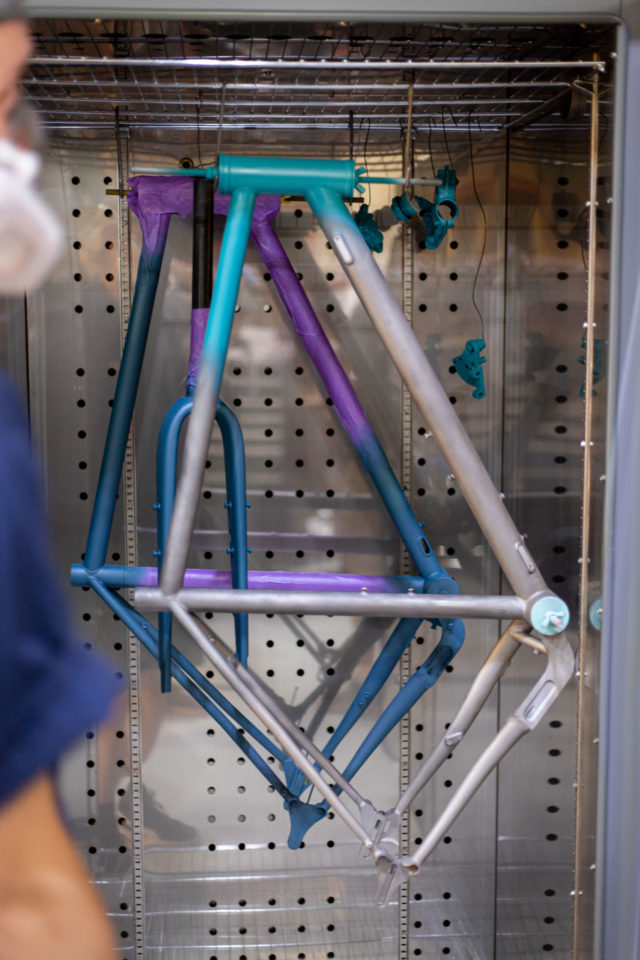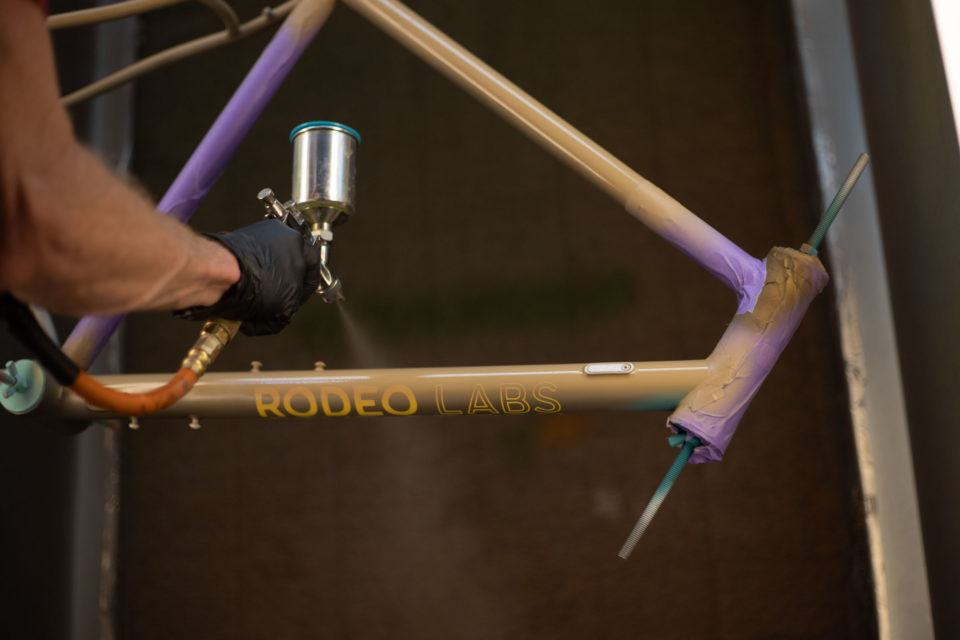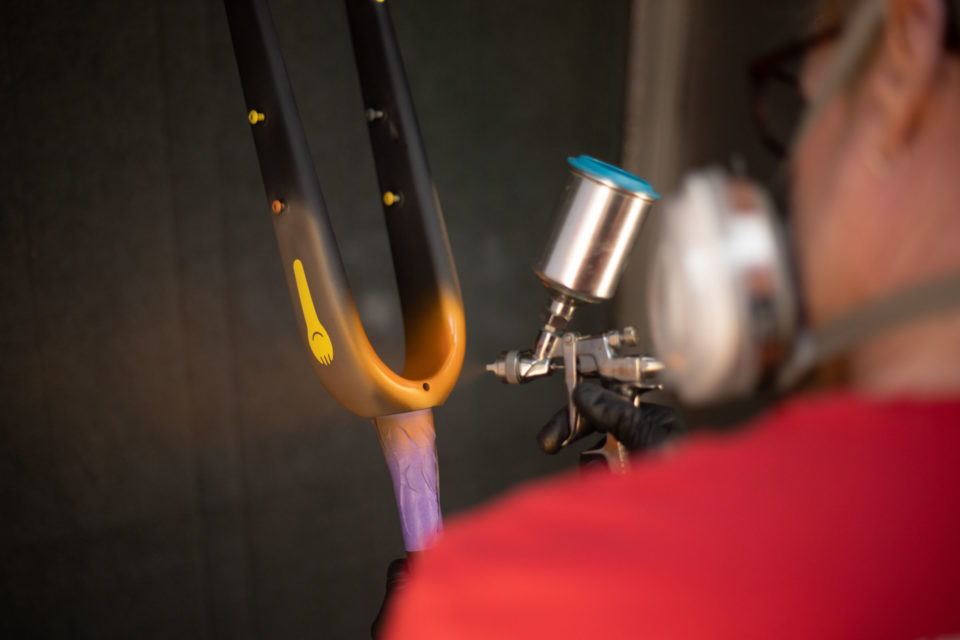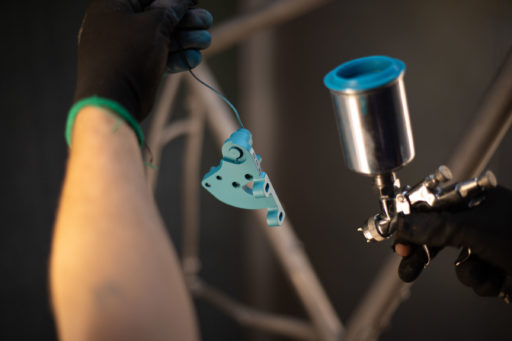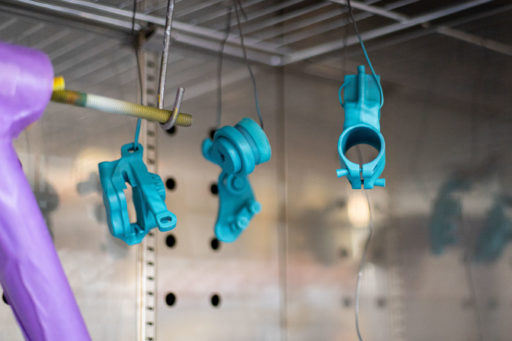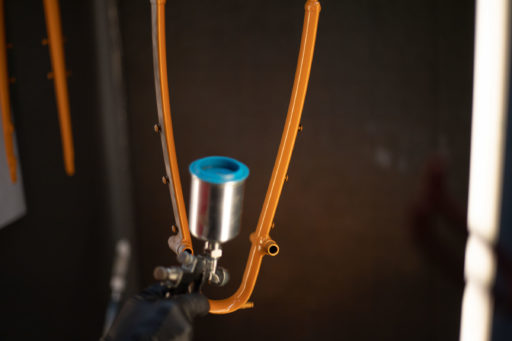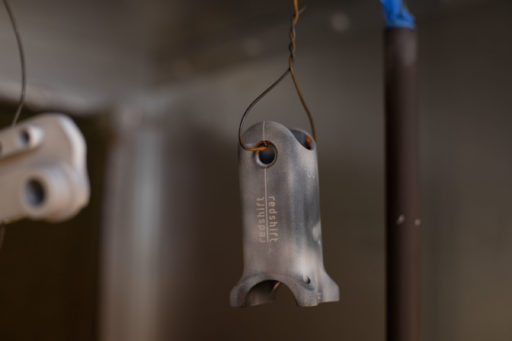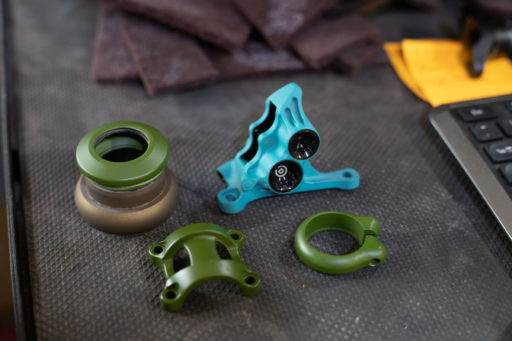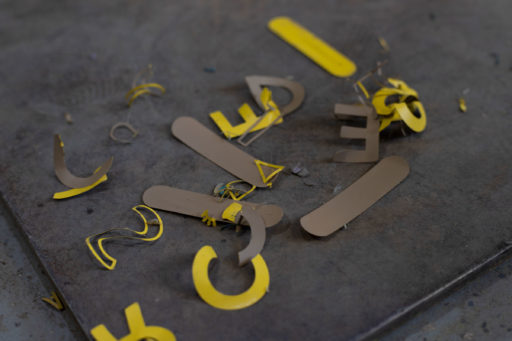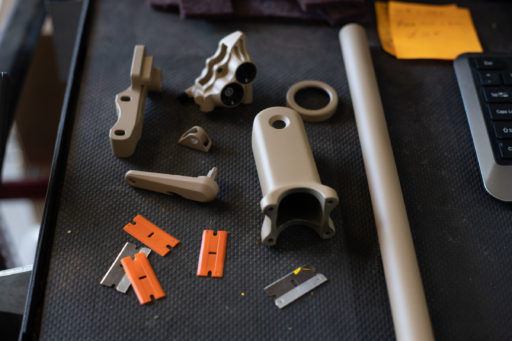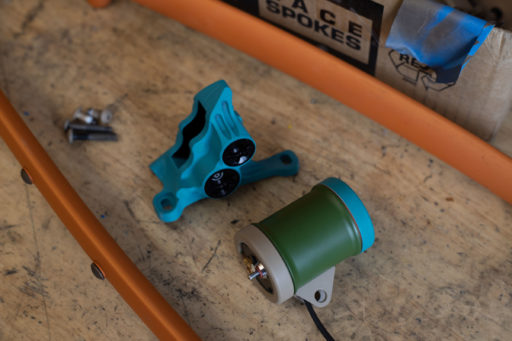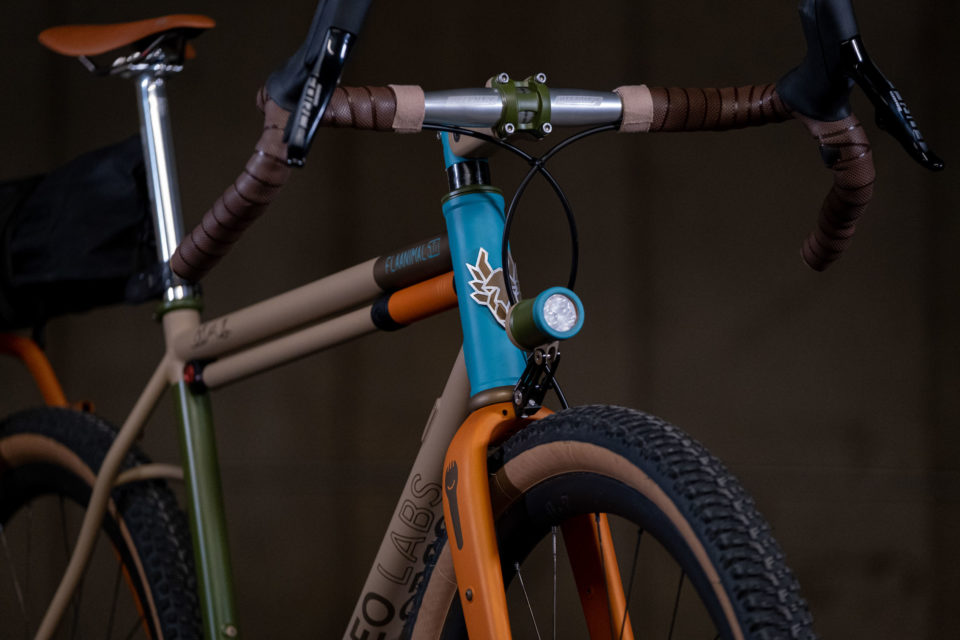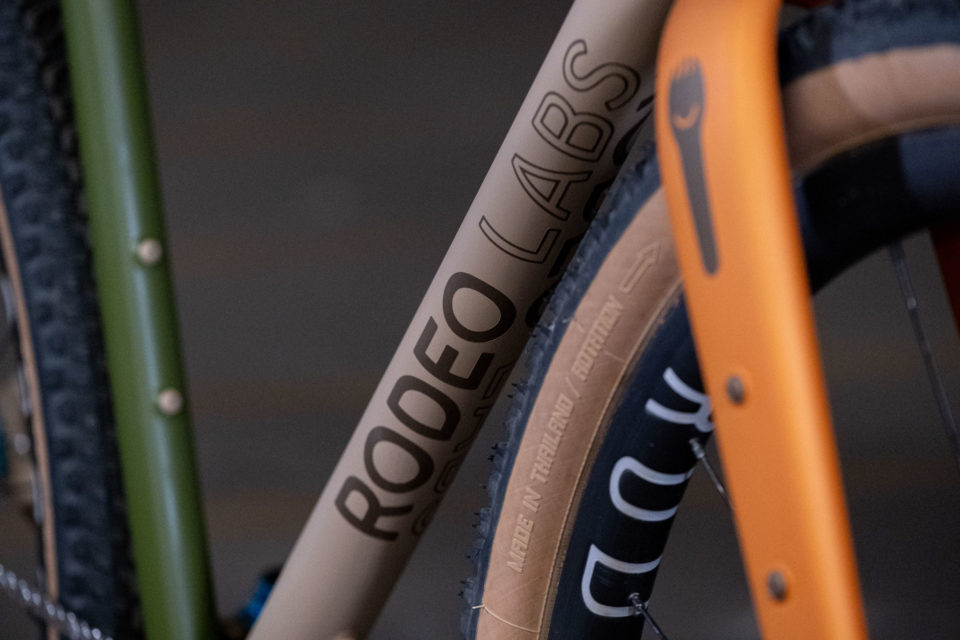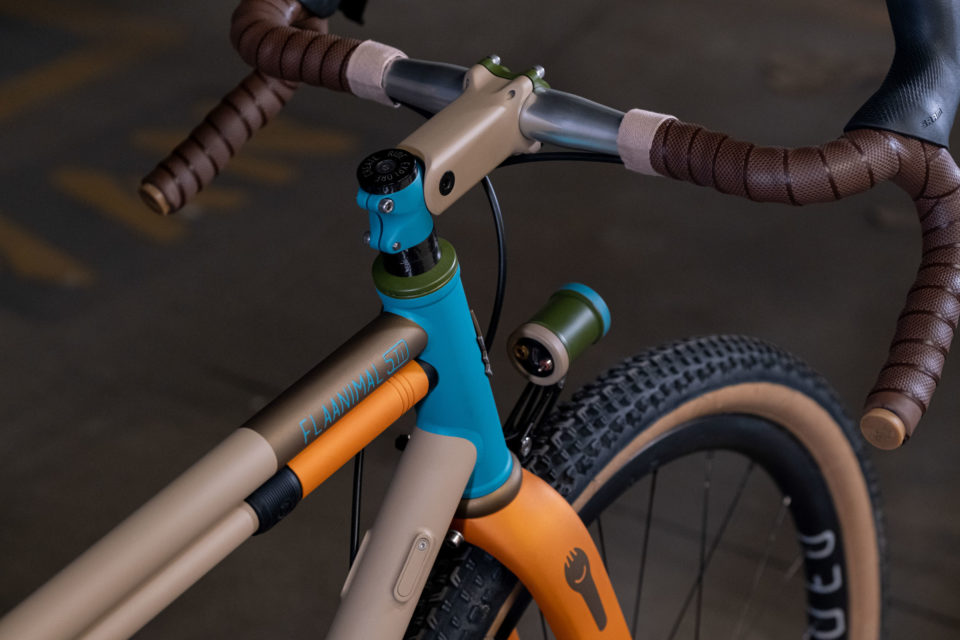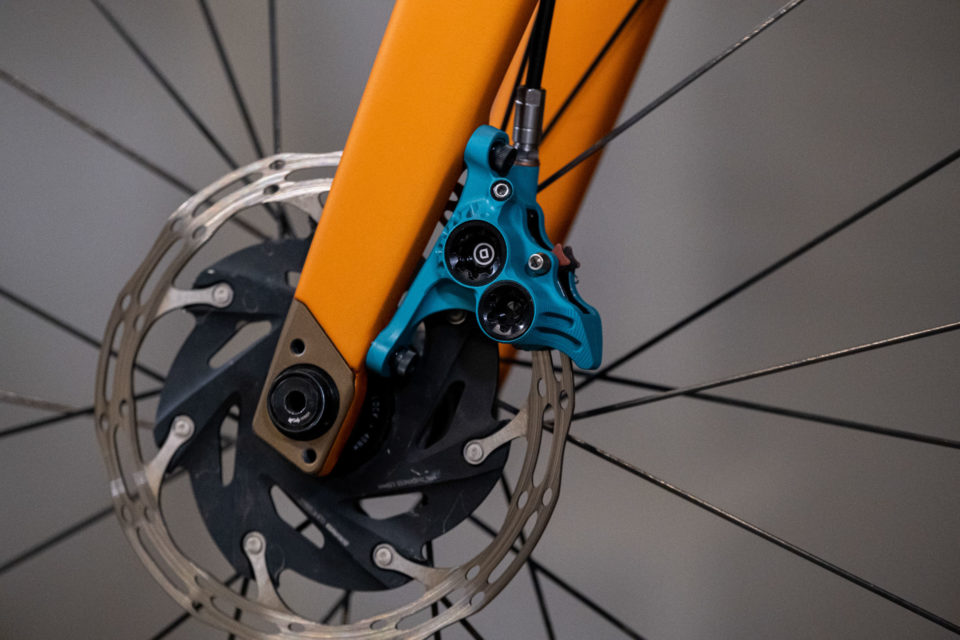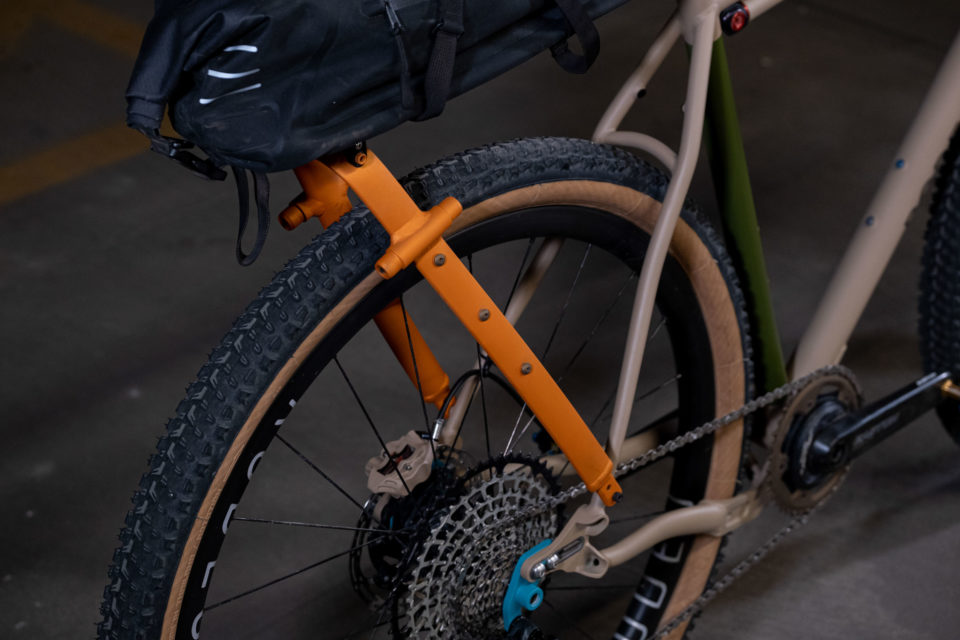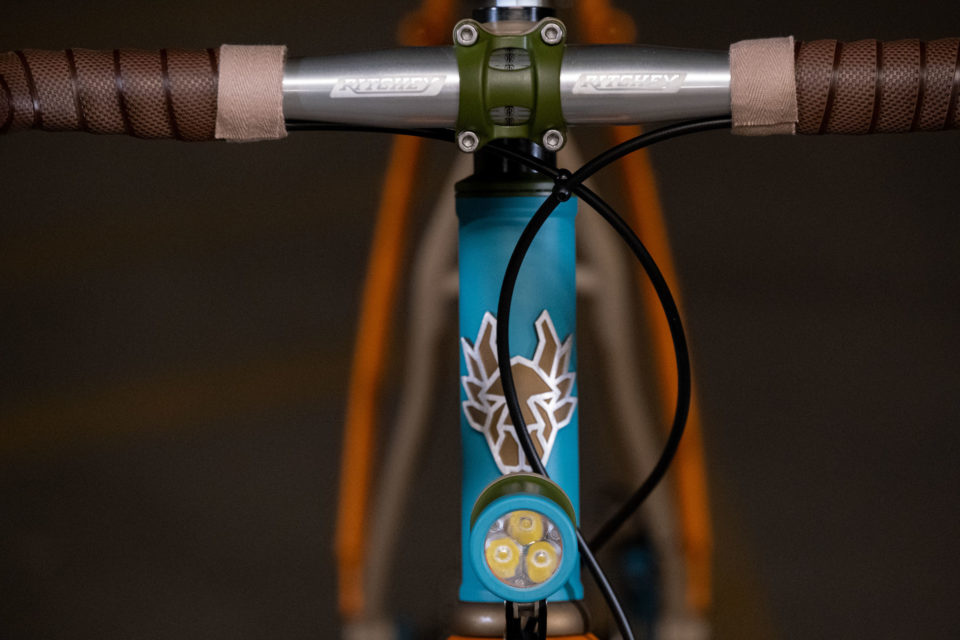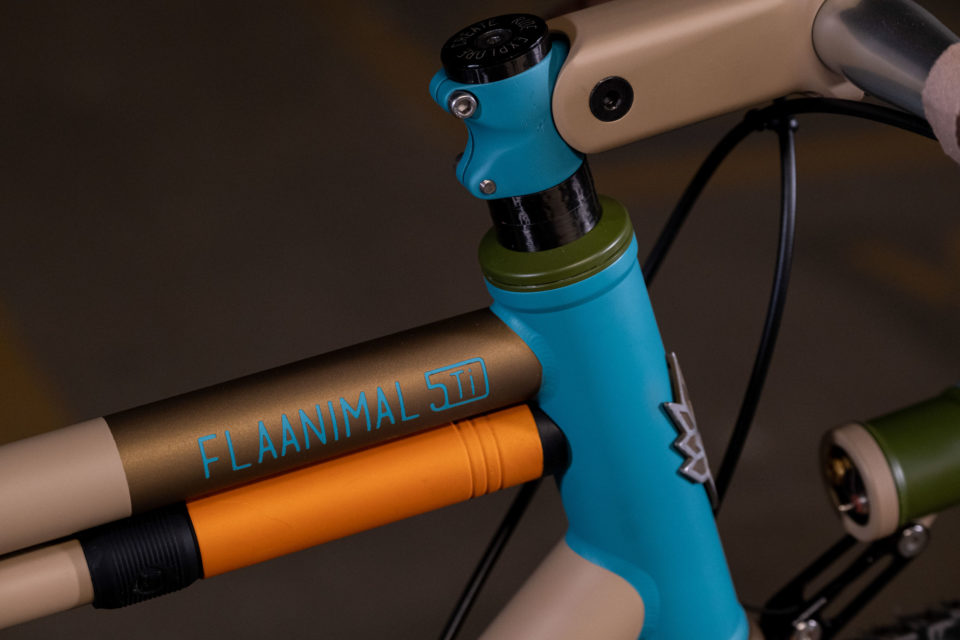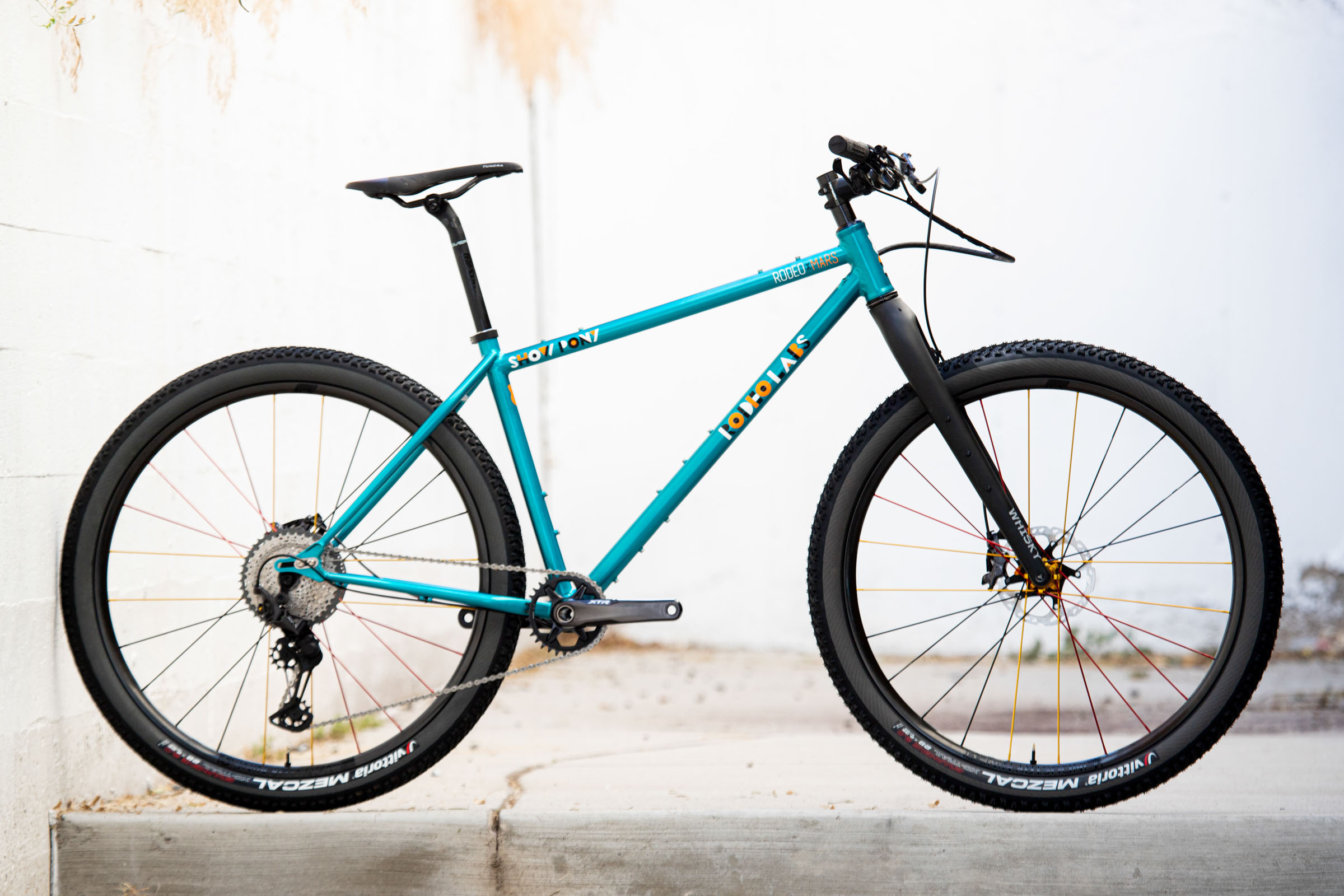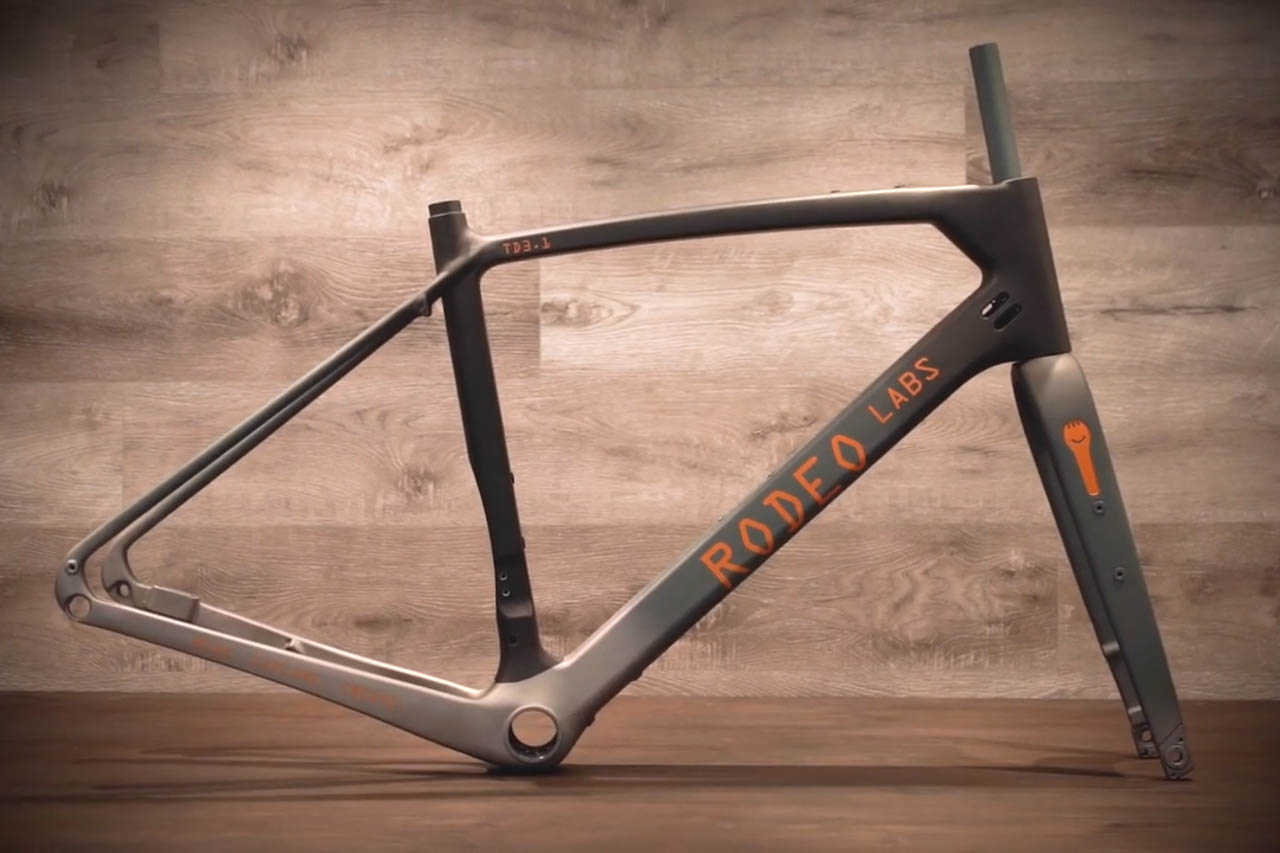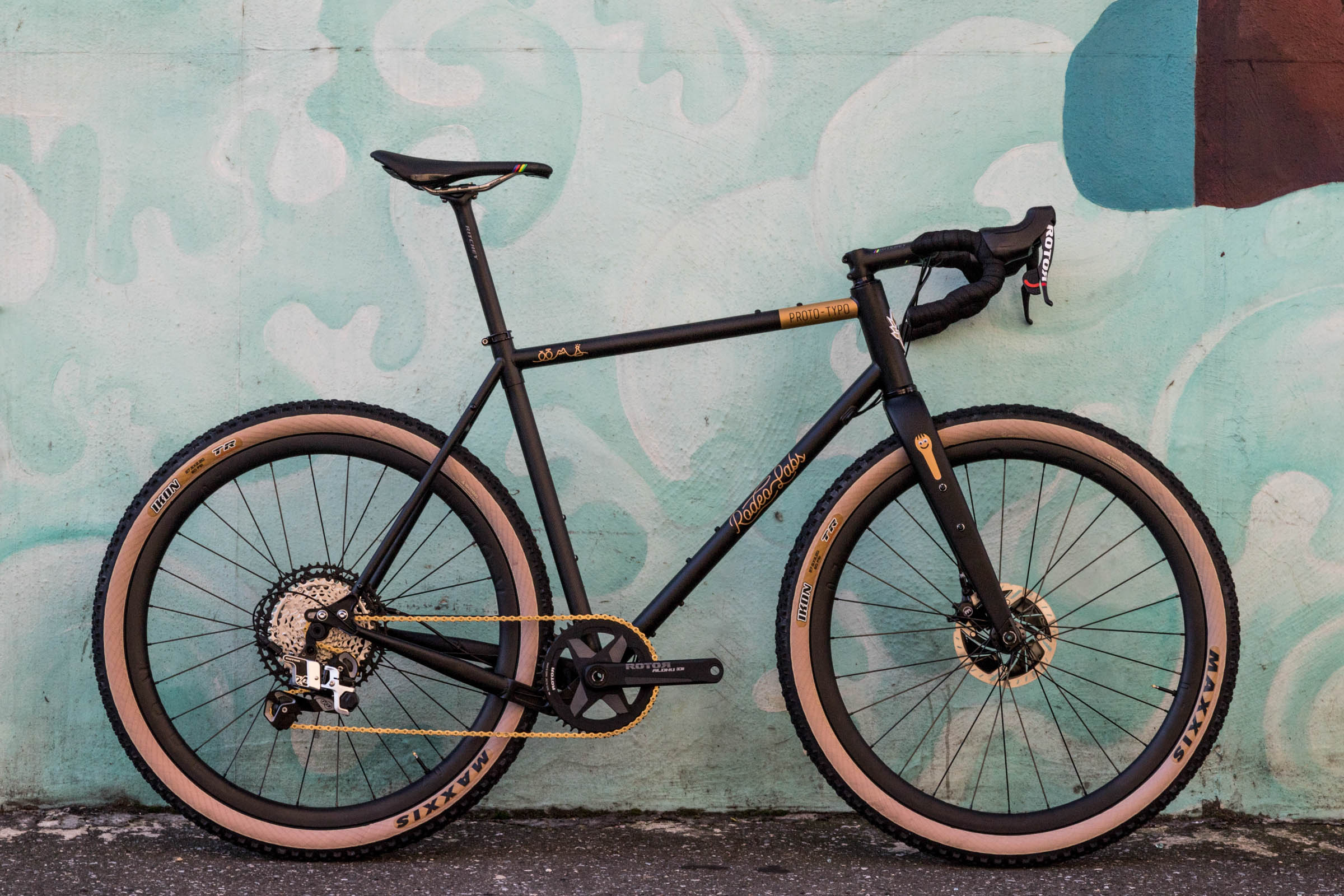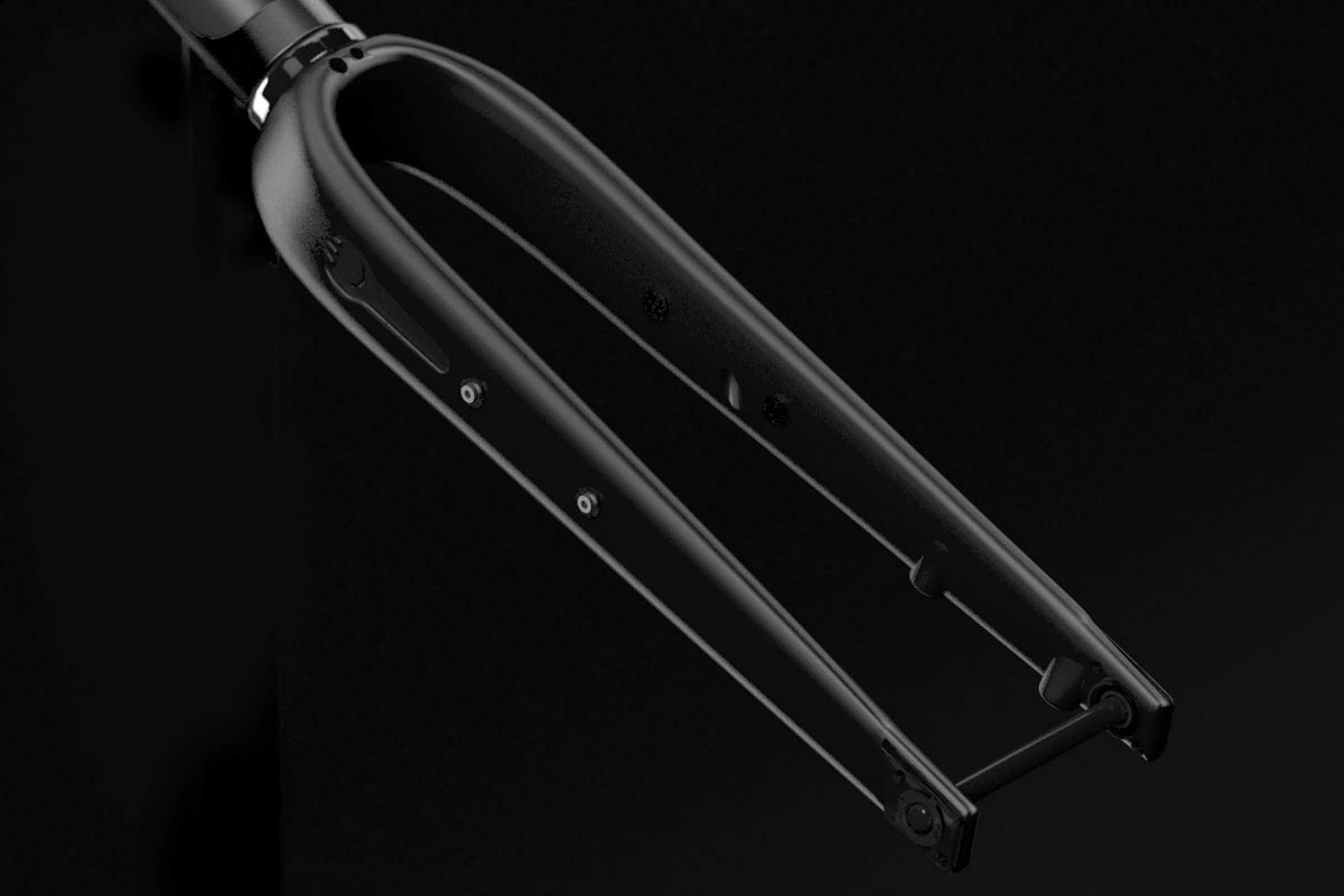An Experiment in Bike Makeovers and Vertical Integration
Part experiment and part solution for a struggling supply chain, Stephen Fitzgerald of Rodeo Labs recently gave his personal Titanium Flaanimal a makeover to teach himself to paint bikes. Learn about how Rodeo Labs has loosened its reliance on outside suppliers and started offering in-house custom paint here, plus a look at Stephen’s Flaanimal makeover…
PUBLISHED May 26, 2022
Like many consumers, I suffer from the very Western problem of boredom, especially as it relates to bikes. No matter how good anything I have is, I slowly but surely develop a curiosity about another part that I want to try, another tire, another bag, and yes, another color. I’m aware that this tendency isn’t a virtue. I fight it as well as I know how.
I’m also in the weird position of running a bike company, so I see a wide cross-section of customers and their buying habits when it comes to purchasing and owning their bikes. It would probably seem natural that I’d like the high-turnover customer who wants a new bike every year or two. Those people are out there, and yes, they do keep the economic furnace of the company stoked with fuel. But my favorite customers are by far the ones who buy and hold their bikes indefinitely, maybe even forever. I was in Arkansas at a gravel event last weekend, and I ran into a customer who had one of our original bikes, and it just made me so happy to see it out there in the wild, being ridden and still loved, many years later. I want to own things that last, and I want to make things that last.
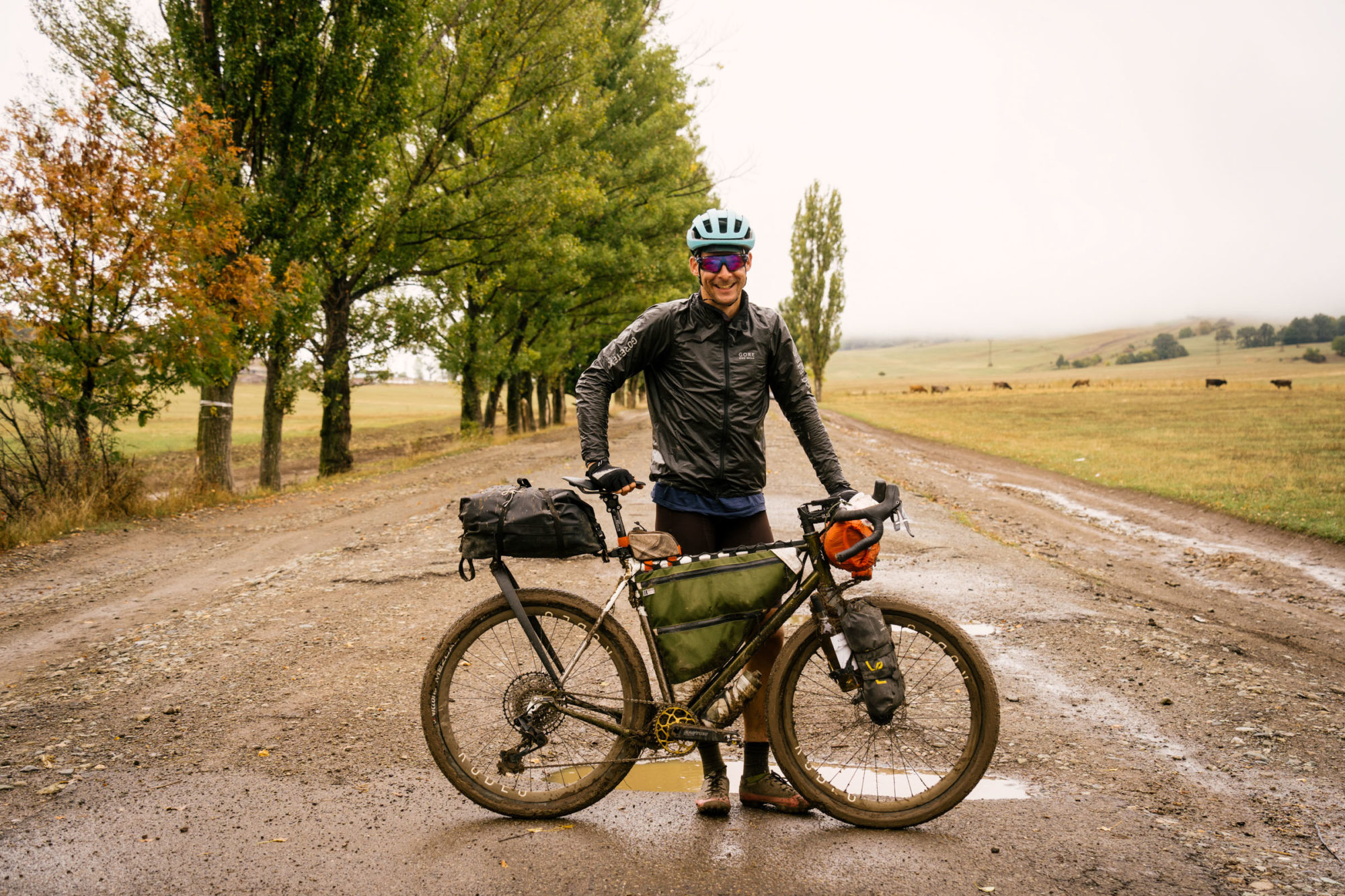
But, per my opening statement, I love variety. I get bored and restless. How can you stay curious and creative without being someone who cycles through gear as if it were all disposable? Let’s not even get into how much new gear costs these days.
In the last few years, instead of getting all new bikes, my go-to has become the bike makeover. I pull the bike apart, clean off the components, sand and strip the frame, and make everything as fresh as possible. Sometimes, new parts are added to the build, but the frameset stays the same—minus a mandatory new coat of paint. These makeovers are incredibly effective for me. They scratch the creative itch, breathe life into a frame that may look worn and beaten up, and make it all feel fresh and brand new—or even better than new because the bike has years of experiences and stories in it. The odometer doesn’t stop moving, but the little “trip” button gets reset back to zero.
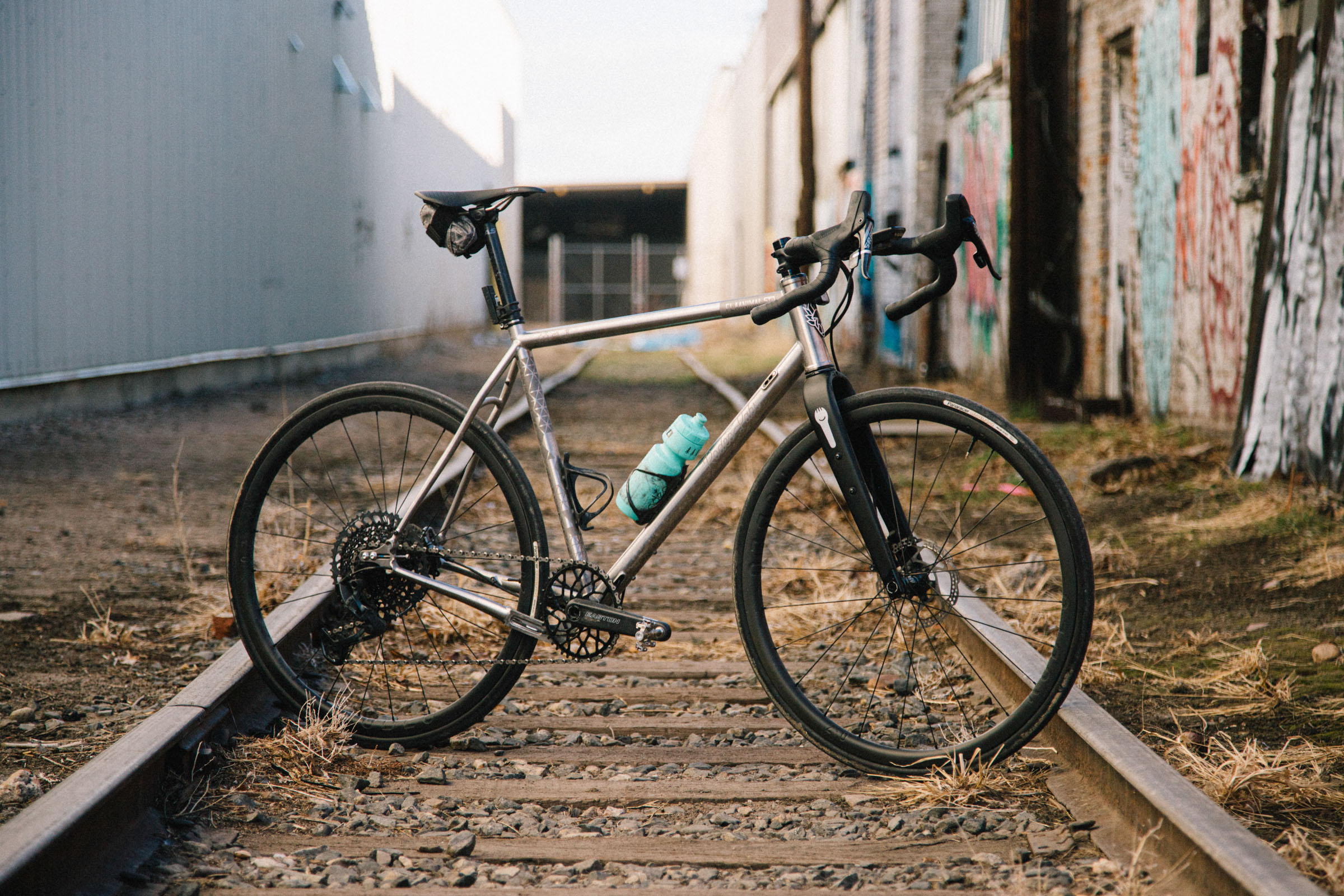
My carbon bike (the Traildonkey) is on its third coat of paint. At first, I rode it with the standard colorway. Then I stripped it and had it painted with a bit of an Icelandic color theme. Finally, that was stripped off, and I asked my wife to repaint it by hand with an illustrated story of our lives together. This final paint job will never be sanded off and covered for sentimental reasons, but I did just crash that bike in a rock garden and punch a hole in the seat stay. That’s being repaired right now, and when it is back in running order, we’re going to hand paint some band-aids over the repaired area to keep the story of the bike going. Non-disposable bikes are a lifestyle.
In 2019, I added a titanium Flaanimal to my fleet of personal bikes, and more than any other bike, this is the one that I’ll probably own until I go bikepacking in the sky someday. Titanium is the sort of metal you’re just supposed to own forever because it’s just so damn durable and beautiful. When I initially built the bike, it was of course tasteful raw titanium with media blasted logos. When it comes to Ti, this is the way. To some, the look of the metal is so perfect as is that it’s almost a crime to paint over it.
But, boredom eventually set in, and I blasted it down and had it painted. Or, more accurately, Cerakoted. Chris at Flux Customs (@flux.customs) here in Denver gave it a lovely, tasteful, white, green, and raw accented look that I was quite fond of… for exactly one year. Boredom was back.
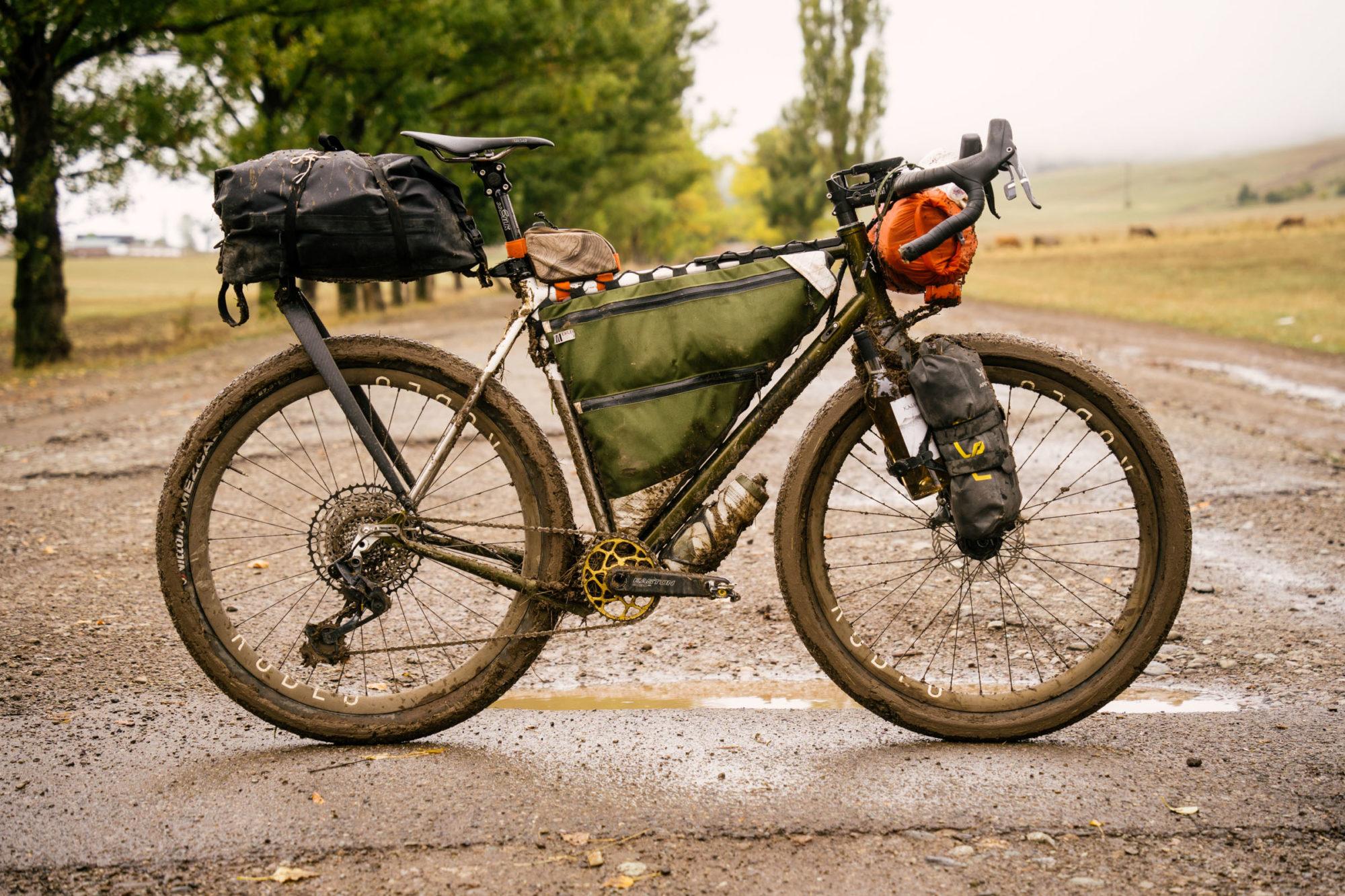
This year, in a moment of impulsivity I asked Conrad—who was here interning for a month—to strip the bike down and blast it all back down to raw titanium once again. He did so with great haste, and the bike then hung on the wall for a month or so, waiting for whatever was next. The problem was that I didn’t know what was next, and I didn’t have any time to figure it out. There are far more important things to do these days than sit around designing another paint layout for myself. Anyone in the bike industry knows that the situation has been bonkers for the better part of two and a half years now, and all of our collective energies have been necessarily focused on impossible tasks like sourcing shifters or getting frames made and landed despite the global logistics chaos that we now live in. Personal projects take the back shelf out of necessity.
One thing we’ve been learning as a company in the last couple of years is that we need to depend less and less on outside suppliers and contractors and more and more on ourselves if we are going to make it through the current chaos and into the future with this company intact. Everyone we’ve depended on at Rodeo in terms of manufacturing, transportation, parts, and logistics has been incredibly strained in recent times, and that strain has made its way into our company and downstream into the lives of our customers. We can’t be so reliant on others anymore. We have to take our fate into our own hands.
We’ve been working on that in a lot of ways, and we’ve been plotting changes for our company. Some have already started to pay off, and others we won’t see the results of for a couple of years still. The truth is right there for everyone to see: the future is vertical. Horizontal supply chain means you depend on a wide range of partners to get your bikes made and delivered. Vertical supply chain means you bring more and more of that process in-house and do it yourself. Depending on partners is less and less reliable in this current world. Depending more and more on yourself is the surest way to control your own survival. Bonus fact: Vertical supply chain is almost certainly more sustainable, even if just on the simple level of transportation footprint. But that’s a topic for another day.
One big change we’ve made at Rodeo in 2022 is building and implementing an in-house Cerakote spray booth so we can work on custom “paint” commissions under our roof. There have been times in the last year when our custom coating line was over a year out, with 50-60 bikes waiting for paint. Customers were enduring absurd waits if they wanted to do something unique with the look of their bikes. I think the record was a customer who waited 14 months for his build. The situation was absurd and was driven by two factors. First, there’s more demand for custom coated bikes than ever before. Second, it’s also a very difficult time to find, hire, and train people who want to do detailed bike coating work. Our situation was unsustainable. Not everyone is willing to wait that long for a bike. Nor should they, honestly. Customers were disappointed in us and they were canceling orders. We weren’t going forward as a company; we were going dangerously backward.
So, we leaned into the problem by expanding our capabilities. We built that booth and got started learning to coat bikes here at Rodeo. At first, the project was overwhelming. Which spray booth to get, which spray gun, which compressor, which filtration. How do we upgrade our electrical to handle it all? How do we dry the air in the lines? Which blast media do we use to strip parts and frames? Which pressure do you use to do that? As far as we know, there isn’t a manual for these things all in one place. The team here did a lot of research and even more trial and error. I don’t want to know how many bikes we’ve made mistakes on and have had to strip and completely do over in order to deliver a quality project to our customers. We did have some help. Chris at Flux customs was amazingly generous, allowing us to pick his brain. You would think that he would have kept all of his incredible knowledge to himself because we were all of a sudden becoming “competition” to his business. But, amazingly, he didn’t see it that way, and the power of relationships won out over that competitive instinct. If he hadn’t shared his knowledge, we wouldn’t be where we are today. Even with our new capabilities, Chris still paints bikes for us. We’ll give him as much work as he can take.
Slowly but surely, we’ve gotten caught up with almost all of our custom coating projects in 2022. There’s still a small queue to get anything custom painted from us, but the team worked super hard here and has turned out so many bikes in 2022. We’ve gotten to such a good place that a couple of weeks back, Pancho and Ryan started dropping hints to me that maybe we should get my Ti Flaanimal off that rack and into the spray booth. Bikes want to be ridden, not hung on the wall. After weeks of prodding, I finally snapped on a Friday afternoon. I went down to the paint building and sorted through the Cerakote colors that we had in stock. There wasn’t really a plan in my head for what I wanted, I just wanted it all to be experimental and most importantly colorful. Generally, when doing customer bikes, a lot of them need to be fairly safe and traditional in their designs. People rightly worry about going over the top with designs and palettes because those things don’t age well when done too aggressively. But none of that applies for my bike. I’m unabashedly in love with color, and comfortable enough with what I like that I can experiment with the risk of doing something in poor taste.
In about half an hour, I worked up a design for the bike and got to work with the remaining prep. At that moment it hit me: Why stop with the frame? What are the limits of coating the components themselves? Can you Cerakote a chainring? How about a brake caliper? A headset? Bolts? How well will it all last? What are the limits of good taste, and do they even matter? To me, they didn’t. I was drunk with spray booth power. We’ve built the capability to paint anything we dream up, so why not let loose and experiment?
I gathered up all of my old, worn-out parts and some new parts and we put them into the media blaster to prep them. Old paint, anno, dirt, grease, etc., all must be banished from a surface before you can properly put new color on it. Media blasting bike parts is deeply meditative and therapeutic. At work, I mostly sit at a desk and pound out an endless stream of emails and spreadsheets all day long. Getting my hands dirty with paint and media blasting work was the most fun I’ve had at work in a long, long time. I think most of the crew here were sort of side-eying me as I worked. Stephen has lost it and is blasting every little nut and bolt into oblivion. Does he have a plan? Does he care about how much work he was creating for himself? I didn’t, really.
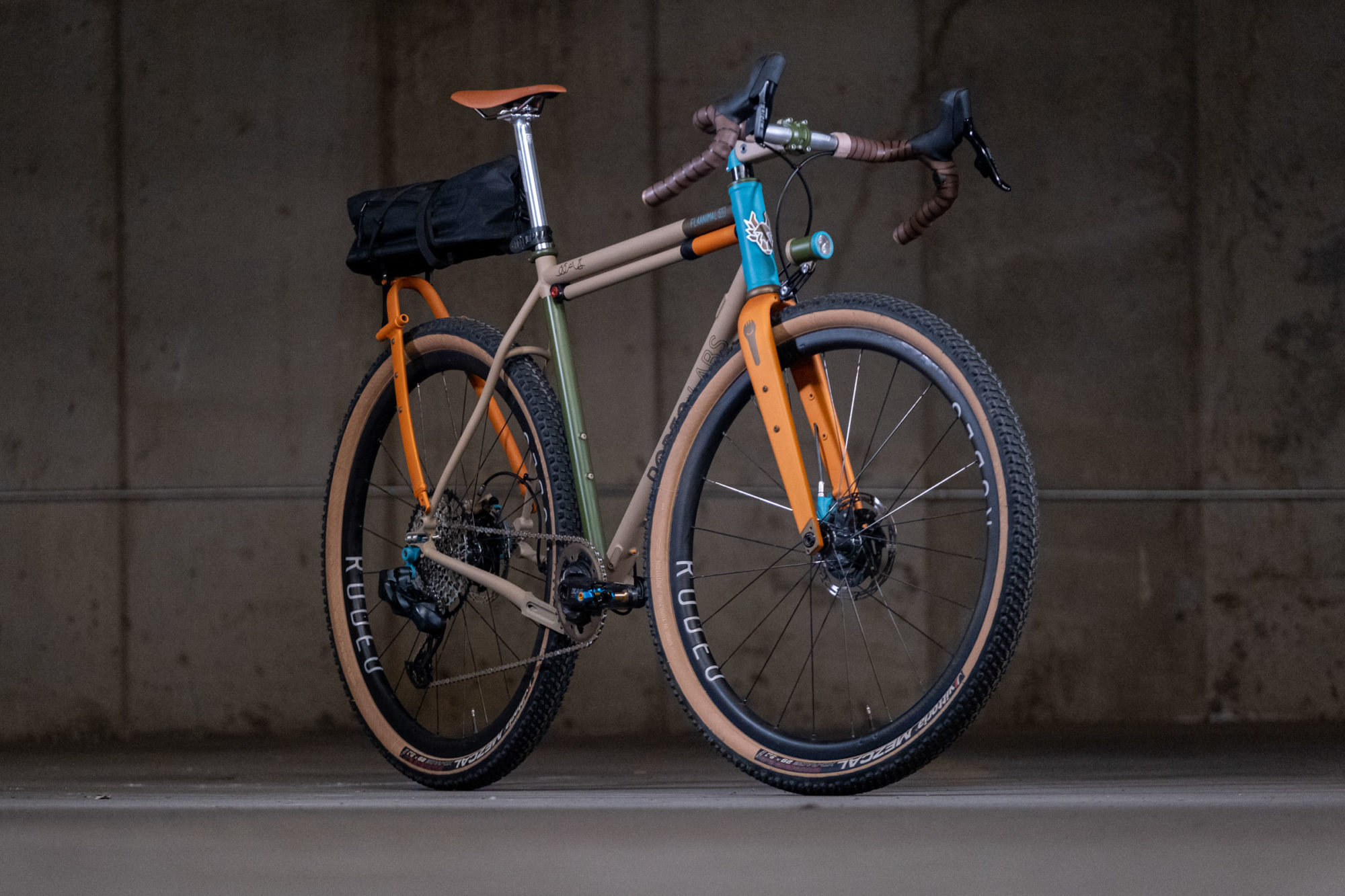
We put the first one of five colors down on the frame and parts on Friday. Ryan came in on Saturday and added a second for me. The following Monday and Tuesday, Pancho and I completed the final layers. Watching the crew at work made me so proud. Not of myself, but of them. They knew what they were doing and they moved with the confidence of veterans only three months into having the whole Cerakote setup operational. Is this what it feels like to build vertical integration? If so, let’s keep going and do more. We will!
Once all the parts had been coated, the masking was weeded and peeled from the frame. Parts were reassembled and torqued. The bike was built. Everyone around the office has been biting their tongue about the final product. I think there’s a general agreement that I’ve lost my mind. The net effect isn’t subtle, or minimal, or maybe even tasteful. But I love it anyway. It isn’t just that the colors are me, it is that the completed project represents a milestone that I can stake in the ground. This little company is growing up. We’re learning, we’re adapting, and we’re improving. It isn’t just me who benefits from this. Everyone at the office does too, and so do our customers. Stress levels go down and happiness goes up when we can do more ambitious things, more creative things, and we can do them passionately and on time.
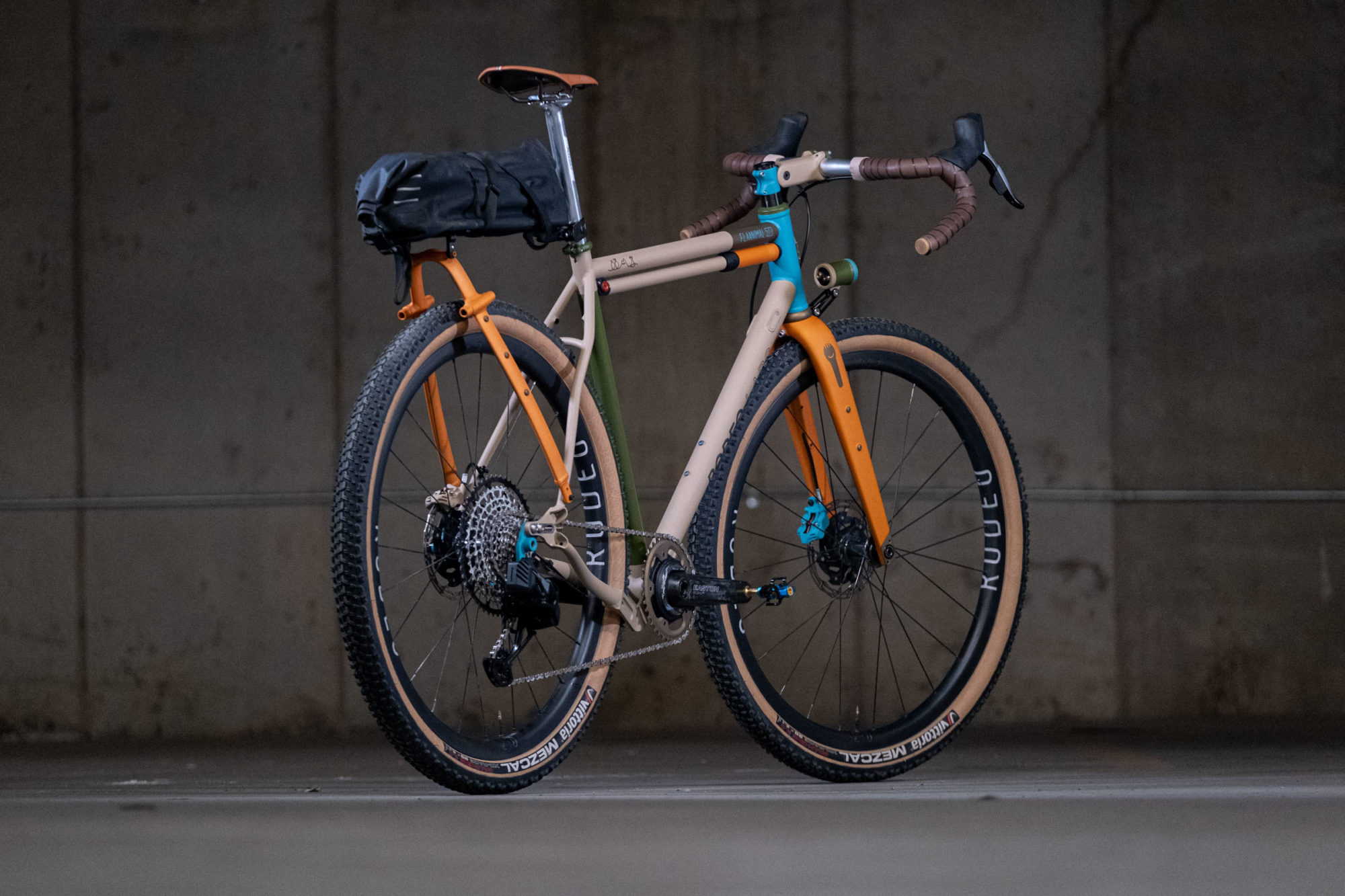
My new bike is already scratched and scuffed, by the way. I took it to that race in Arkansas and it got absolutely obliterated in mud and grit. Not even a week in and the bike feels lived in, not brand new. Such is the circle of bike life for me. Will I blast this thing back down and redo it again in a year, or will this design stand the test of time? I don’t know. It’s better to live in the moment with such things.
Related Content
Make sure to dig into these related articles for more info...
Please keep the conversation civil, constructive, and inclusive, or your comment will be removed.







